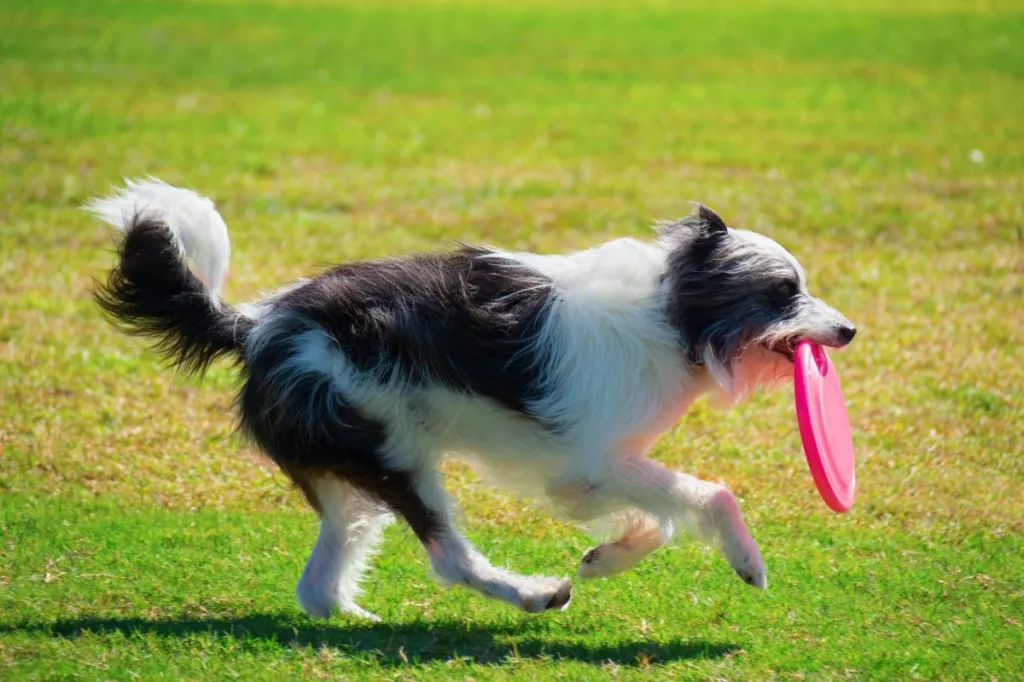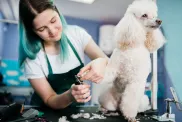The Bordoodle, also called the Borderdoodle, is a medium-to-large-sized crossbreed between the Border Collie and the Poodle. This unique Poodle mix has a well-muscled frame with a coat that ranges from gently waved to curly. With their alert expression and an air of quiet confidence, the Bordoodle is a winning combination of two beloved breeds.
Aside from their eye-catching looks, the Border Collie Poole Mix’s indomitable spirit truly sets them apart. Inheriting the relentless work ethic and keen intelligence of their herding parents, this crossbreed thrives on mental and physical challenges. With proper outlets for their boundless energy and positive reinforcement training, the Bordoodle is equally at home on the athletic field or cuddled up beside their adoring family.
Bordoodle characteristics
- Height: 12 to 22 inches at the shoulder
- Weight: 30 to 60 pounds
- Lifespan: 12 to 15 years
Coat and color variations
The Bordoodle’s coat and color depend on the dog’s parent. Due to the uncertainty of genetics, the coat may be curly and hypoallergenic like a Poodle, or closer to the silky or even straight coat of the Border Collie. Colors can be black, white, brown, fawn, or a combination.
Physical traits and appearance
The Bordoodle or Borderdoodle, is a medium-sized and athletic mixed breed, often with a lean build that reflects the agility and stamina inherited from the Border Collie.
- Soft, Curly Coat: The Borderdoodle’s head is typically well-proportioned, with a soft, curly, or wavy coat that covers their face and body, a hallmark of their Poodle lineage.
- Expressive Eyes: Their eyes are expressive, often round or almond-shaped, and convey a friendly, intelligent demeanor.
- Floppy Ears: The ears are usually floppy, framing the face in a playful, gentle way, which adds to their approachable and friendly look.
- Tail: The Border Collie Poodle mix’s tail is long and often feathered, carried high or wagging with enthusiasm, showcasing the dog’s lively and affectionate personality.
How big does a Bordoodle get?
The Bordoodle is usually described as a medium-sized dog. Although, as is always the case with newer dog breeds, exact size standards might vary. Most weigh in at 30 to 60 pounds and range in height from twelve to 22 inches.
Bordoodle personality
When people describe their Bordoodles, they usually say that they’re both highly sociable and extremely intelligent dogs. They usually get along great with families and love to become a part of daily activities and routines. While Borderdoodles are happy to chill out and snuggle, they’re also more than eager to join in play sessions with the kids.
It may not come as a surprise considering the Borderdoodle’s parent breeds are two of the most intelligent breeds, but they are incredibly sharp and highly trainable. You’ll need to make sure they’re mentally stimulated to ensure they don’t get bored and resort to unwanted behaviors. Fetch, agility, or herding-style tasks are a great challenge for them.
Also, be aware that the Bordoodle will quickly become protective towards the family that adopts them. While the mixed breed might not look like a classic guard dog, they will prove wary of strangers. This is a dog who’s loyal to the people who show them love and will need socialization to ensure they’re well-behaved around unfamiliar people and dogs.

Temperament and behavior
- Eager to Please: Very responsive to training and enjoys learning new commands and tricks.
- Energetic and Playful: While this temperament is perfect for active households, they require plenty of physical and mental stimulation.
- Affectionate and Loyal: Strong bond with their family, often seeking attention and companionship.
- Alert and Watchful: Can have a protective instinct from the Border Collie side, alerting owners to new people or changes.
- Good with Children: Typically gentle and patient with children, especially in a family setting.
Training and socialization
Early socialization and positive reinforcement training are crucial due to their intelligence and potential stubbornness. Of course, their intelligence allows them to pick up commands quickly, so early training is key to establishing good behavior from the start. Use praise, treats, and affection to reward desired behavior. Borderdoodles respond well to positive reinforcement, and this approach will keep them motivated and engaged.
Training tips:
- Be Consistent: Consistency is crucial in training. Use the same commands and routines to avoid confusion. This helps your Borderdoodle understand what is expected of them.
- Keep Training Sessions Short and Fun: Borderdoodles are intelligent but can lose interest if training sessions are too long or repetitive. Keep sessions short (10-15 minutes) and engage with varied activities.
- Mental Stimulation: Incorporate puzzle toys, obedience training, and interactive games into their routine to challenge their mind. A bored Borderdoodle can become restless or destructive. Once basic obedience is established, teach more advanced commands or tricks. Their intelligence makes them excellent candidates for agility training, fetch, or scent games.
How long can the Bordoodle be left alone?
Bordoodles are highly social dogs and generally do not do well when left alone for long periods. They thrive on companionship and interaction, both because of their affectionate nature and their intelligence. Ideally, a Bordoodle should not be left alone for more than 4 to 6 hours at a time.
Bordoodle care
As with all dogs, it’s important to keep up your Bordoodle’s regular veterinary checkups to detect any health concerns early. Your vet can help you develop a care routine that will keep your dog healthy.
How much exercise does a Bordoodle need?
A couple of walks every day, totaling around 45 minutes, should do the trick to keep your Bordoodle happy and healthy. However, due to their remarkable intelligence, it’s of great benefit to incorporate obedience tasks into the exercise mix to keep them interested and mentally stimulated.
Bordoodle grooming needs
The Bordoodle’s coat comes in an array of colors, patterns, and textures depending on their genetic makeup. The coats usually incorporate a mix of black, white, gray, and brown and are typically somewhere between medium and long in terms of length. It is often described as soft to the touch and wavy. Like other Poodle mixes, they don’t typically shed much and are usually considered hypoallergenic. Remember that this does not mean they do not cause allergies, only that they’re less likely to do so.
How to groom a Bordoodle
Grooming a Borderdoodle (or Bordoodle) involves maintaining their coat, ears, nails, and teeth. Their grooming needs can vary depending on whether they inherit more of the Poodle’s curly coat or the Border Collie’s wavy/straight coat.
Coat care
Brushing:
- Frequency: Brush your Borderdoodle 2-3 times per week to prevent matting and tangles, especially if they have a curly or wavy coat. If their coat leans more toward the Poodle side, you may need to brush daily.
- Tools: Use a slicker brush or pin brush for their curly or wavy coat, and a comb to detangle any knots.
- Tip: Pay extra attention to areas that are prone to matting, like behind the ears, under the legs, and around the collar.
Bathing:
- Frequency: Bathe your Borderdoodle every 4-6 weeks or as needed. Frequent baths can dry out their skin, so stick to a gentle dog shampoo.
- Drying: After a bath, towel-dry and use a blow dryer on a low, cool setting if necessary. Make sure their coat is fully dry to prevent any moisture from causing irritation.
Trimming:
- Professional Grooming: If your Borderdoodle has a curly or thick coat like a Poodle, consider having them professionally groomed every 6-8 weeks. Groomers can shape the coat, keep it manageable, and trim around sensitive areas like the paws, face, and tail.
- Home Trimming: You can trim their coat at home using dog clippers or scissors for a tidy appearance, especially around the eyes and paws to avoid irritation.
Ear care
- Check for Dirt and Moisture: Borderdoodles with floppy ears (inherited from the Poodle) are more prone to ear infections. Check their ears weekly for signs of dirt, wax buildup, or moisture, which can lead to infections.
- Cleaning: Clean their ears with a veterinary-approved ear cleaner and a cotton ball or pad. Avoid using cotton swabs, as they can push debris further into the ear.
Nail trimming
- Frequency: Trim your Borderdoodle’s nails every 4-6 weeks, depending on their activity level. Active dogs may naturally wear down their nails, but indoor or less active dogs will need more frequent trims.
- Tip: Use a dog nail clipper or a grinder. Be careful not to cut too far down, as hitting the quick (the blood vessel inside the nail) can be painful and cause bleeding.
Dental and eye care
- Brush Regularly: Brush your Borderdoodle’s teeth 2-3 times per week using a dog-specific toothbrush and toothpaste. This helps prevent plaque buildup and dental issues.
- Dental Chews: Provide dental chews or toys to help reduce plaque and keep their teeth healthy.
- Clean Around the Eyes: If your Borderdoodle’s coat grows around their eyes, regularly trim the hair to prevent irritation. Use a clean, damp cloth to gently wipe away any eye discharge or tear stains.
Check for skin issues
- Inspect Regularly: As you groom, check their skin for any signs of irritation, redness, or bumps. If you notice anything unusual, consult a vet.
Flea, tick, and parasite control
Keep up with flea and tick prevention treatments, especially if your Borderdoodle spends much time outdoors. Regular grooming allows you to spot parasites early.
Early acclimation is key
Getting your Bordoodle accustomed to grooming procedures from a young age makes the process easier and more enjoyable for both of you. Handle their paws frequently, examine their mouth and ears, and reward them for good behavior during grooming sessions. This positive foundation sets the stage for stress-free veterinary exams and handling throughout their lives.


Feeding and nutrition
An ideal Bordoodle diet should be formulated for a medium breed with medium energy. Bordoodles need to stick to a healthy diet, as overeating can cause weight gain and associated health problems, especially if adequate exercise isn’t offered.
As with all dogs, the Bordoodle’s dietary needs will change from puppyhood to adulthood and will continue to change into their senior years. You should ask your veterinarian for recommendations about your Bordoodle’s diet, as there is far too much variation among individual dogs–including weight, energy, and health–to make a specific recommendation.
- Adult Portions: Feed an adult Borderdoodle based on its weight, size, and activity level. On average, a medium-sized adult (30-50 lbs) Borderdoodle will need about 2-3 cups of dry food per day. A larger dog (50-60 lbs or more) may need 3-4 cups per day.
- Adjust According to Activity Level: Highly active Borderdoodles, especially those engaged in agility training or long runs, may need more food than less active ones. Always monitor their weight and adjust portions accordingly.
Bordoodle and family compatability
Bordoodles are highly compatible with families due to their affectionate, intelligent, and playful nature. They bond closely with their family members, making them loving and loyal companions. Their social and friendly demeanor allows them to get along well with other pets and strangers.
Being a highly intelligent breed, Bordoodles are quick learners and enjoy engaging in training and family activities. They thrive in active households that can provide plenty of physical and mental stimulation. Bordoodles love outdoor play, hiking, and spending time with their family, but their energy needs require consistent exercise to prevent boredom. While they are generally easygoing, some may display herding tendencies, which can be managed with proper training.
Is the Bordoodle good with children?
Their gentle temperament, especially with children, makes the Bordoodle an excellent choice for families with kids. They are patient and playful, keeping up with the energy of children while also being careful and protective. Because of their herding ancestry, they may try to herd children and exhibit nipping tendencies. Firm, but positive reinforcement training should be used to curb this habit.
As with every breed, you should always teach children how to approach and touch dogs and supervise any interactions between dogs and young children to prevent biting or ear or tail pulling on the part of either party. Teach your child never to approach any dog while it’s eating or sleeping or to try to take the dog’s food away.
Bordoodle health issues
Like all breeds, Bordoodles have potential health concerns. Responsible breeders prioritize genetic health testing to minimize these risks.
- Progressive Retinal Atrophy: Progressive retinal atrophy is an inherited condition that can occur in Bordoodles, leading to gradual deterioration of the retina and potential blindness. Regular eye exams are recommended to monitor for this issue.
- Epilepsy: Both Border Collies and Poodles can potentially pass down a genetic predisposition for epilepsy to Bordoodles, a neurological condition characterized by recurring seizures. Proper treatment is important if epilepsy develops.
- Hip Dysplasia: As a larger breed, Bordoodles may inherit a tendency towards hip dysplasia from their parents, where the hip joint doesn’t form properly, leading to arthritis and lameness over time.
- Collie Eye Anomaly: The Bordoodle may be at risk for Collie Eye Anomaly from its Border Collie lineage – an inherited defect that affects eye development and can impair vision if not treated appropriately.
- Addison’s Disease: Addison’s disease is an endocrine system disorder that Poodles are prone to, and may potentially affect Bordoodles, causing insufficient production of vital hormones by the adrenal glands.
Bordoodle rescue groups
It may be hard to find a breed-specific rescue for Bordoodles because they are a mixed breed. However, you may want to try Border Collie or Poodle breed-specific rescues, as they often care for mixes, as well. Here are some rescues you can try:
If you choose to buy a puppy, finding a reputable dog breeder is crucial. Reputable breeders are committed to breeding healthy, well-socialized puppies that will make great companions. They will screen their breeding stock for health problems, socialize their puppies from a young age, and provide you with lifetime support.













